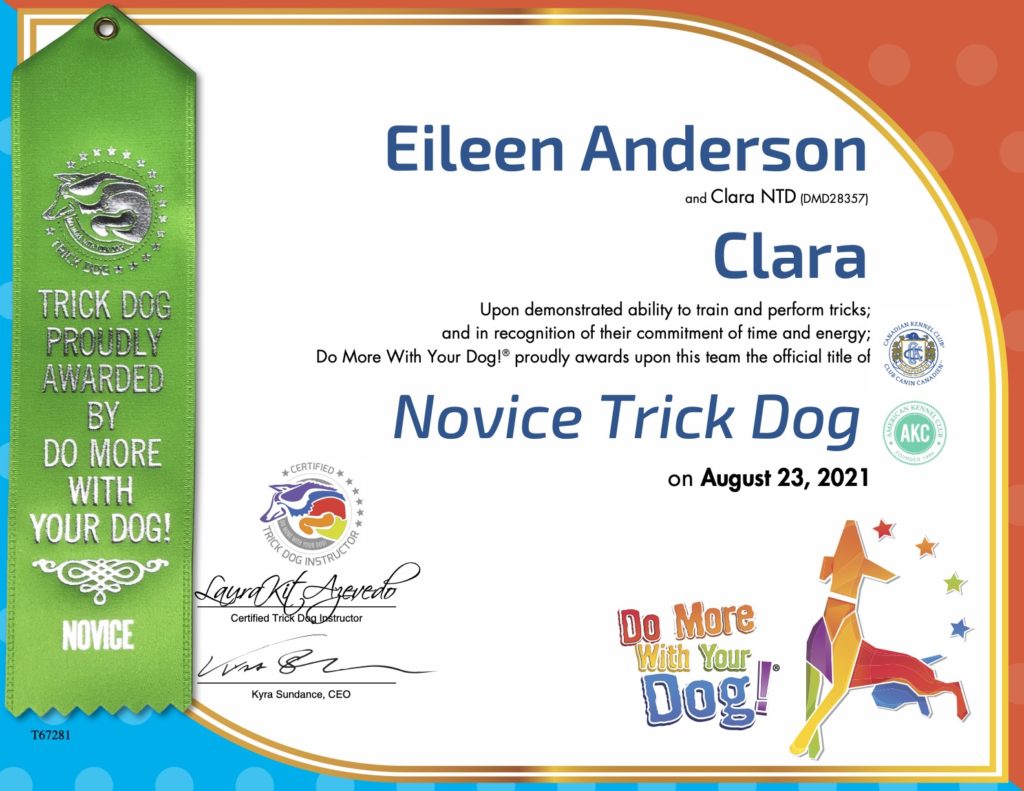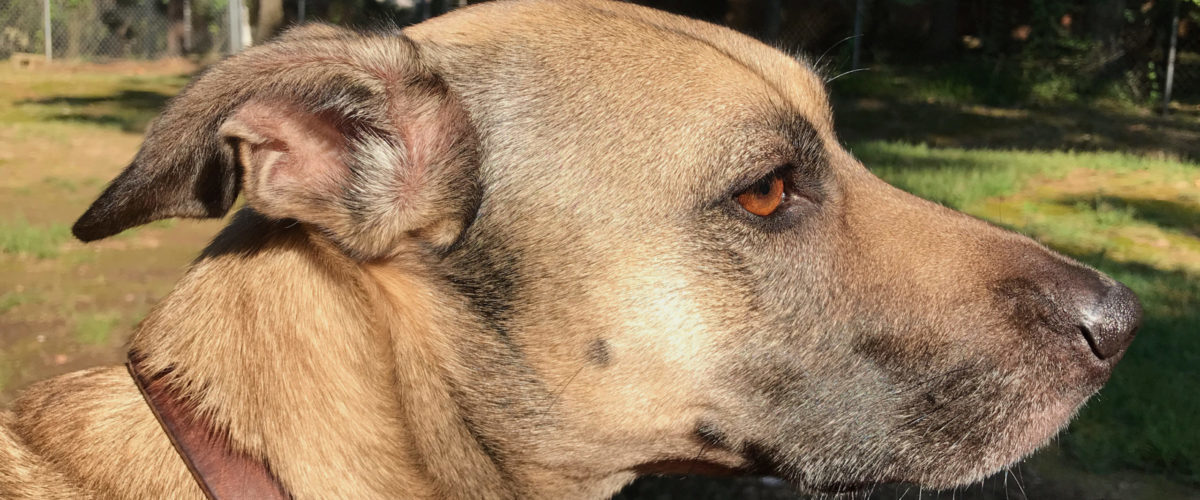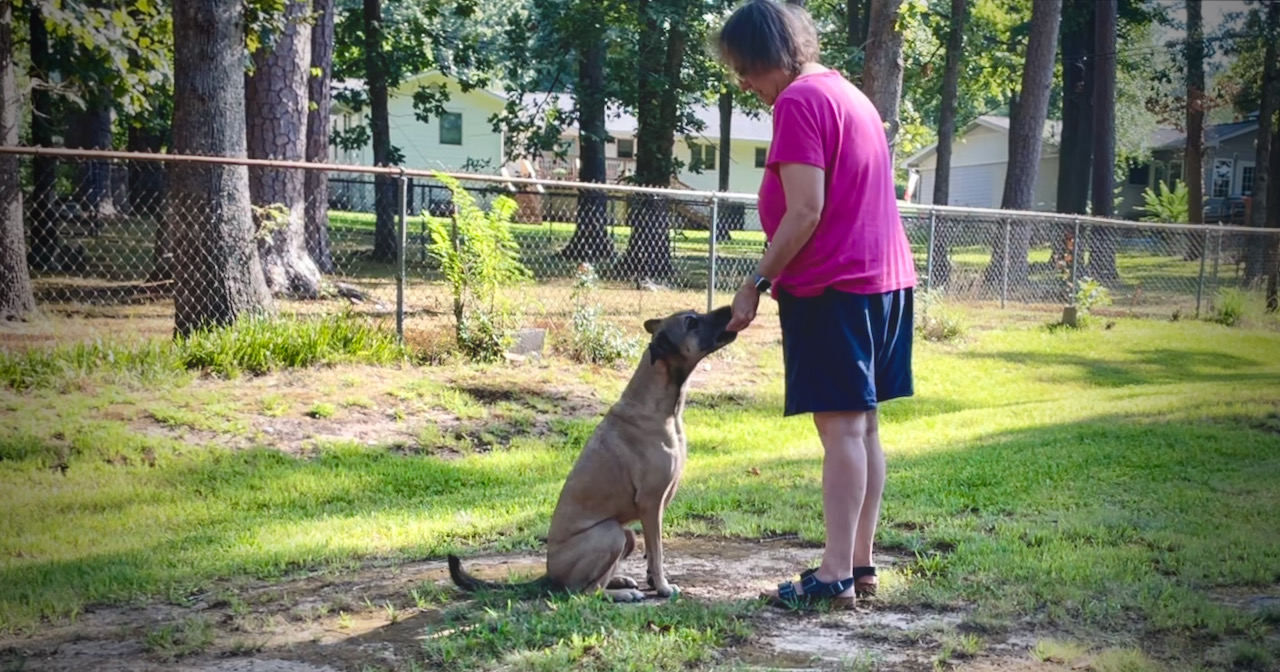To keep us both on our toes, I am starting to teach 10-year-old Clara every trick I can get my hands on that is safe for her and that she enjoys. Going to grab some online titles on the way (these are judged via video). Titles are reinforcing to me and often the requirements jolt me out of my training ruts.
These posts will be both here and on my Eileenanddogs blog. For now, my plans are that it will be the same material. If you don’t want to have to search for the tricks posts among all the different topics on Eileenanddogs, use this one because the tricks posts will be the only ones here. There’s also a little intro that also gives a little more background about why I embarked on this project. I’ll get a subscribe option up soon.
We started with our novice trick title for Do More With Your Dog. For this first go-round, I picked things Clara already knew and could do fluently. Hey, I wanted a little immediate reinforcement! But also, I was honest about it. When it turned out I was wrong about the fluency and she struggled with puppy pushups and a new target stick, we saved those for later. I could have gotten the behaviors well enough to pass the criteria for the test, but passing at all costs is not my goal. I want to do some good training. I don’t have to have everything on verbal cue (thank goodness) or stimulus control, but I want a modicum of understanding of the behavior. And the failures (see below) are so instructive about the flaws in my training.
I do aim to get better cue recognition along the way. I’ll be working on duration (with myself—Clara does whatever I ask of her!) as well.
A large part of my motivation is that Clara needs more enrichment in her life. Throughout these 10 years, I’ve learned that playing training games is one of her very favorite things. So here we go with every trick I can get my hands on.
Here’s the first batch.
Clara is virtually always this happy when training. This video earned Clara her Novice Trick Dog title with Do More With Your Dog. Thank you to Kit Azevedo for judging our video.
Training Errors
So far, the behaviors are mostly kindergarten behaviors—it feels like a stretch to refer to them as tricks. But a couple of them took some skill. The things I thought we could do that we couldn’t are far more interesting! Here’s a list of the things you can see on the following “Informative Failures” video. I’ll discuss them below after the video.
1. I make her break her stay on a cot by saying her name in a way that resembles our recall cue.
2. I forget to release her from her cot, she stays 60 seconds, and I don’t notice or reinforce.
3. We fail puppy push-ups.
4. We fall apart when I use a new target stick
5. (Not on video.) I cue her to jump, she takes me literally, and jumps into the jump instead of over it.
The following video is not quite funny enough to qualify as a blooper video, although I found some things amusing. But then, I always laugh a lot when we work together.
Reasons for Errors
The reasons for the “errors” that Clara made (I’m using scare quotes because they are not really her errors) are so clear to me. They are due to matching law effects and reinforcement history, both schedules of reinforcement and patterning on my part.
1. Breaking her stay when I say her name. People warn against using a dog’s name as a recall cue, and this is the reason. But it’s not usually a problem for us. I use a special tone and inflection for her recall cue (you hear it later in the video). It’s different from my normal way of speaking to her, but when she was staying on her cot, I inflected her name just enough to make her come to me. My bad.
2. Staying on her cot because I forget to release her. This isn’t a mistake at all, it’s a lovely success, except it would have been nice of me to reinforce her after that great stay while I was walking all around and setting things up. But no, I jumped right into cueing the next behavior.
3. Puppy push-ups. Here’s where it starts to get interesting. The puppy pushups chain consists of repeating the behaviors of sit, down, sit, down, sit, down, on cue. What half-way trained dog can’t do this? Answer: a dog whose trainer has been emphasizing stand on and off for the past two years and tends to ask her for a pattern of sit, down, sit, stand. My pattern overruled her recognition of the verbal cues. Not to mention that I usually reinforce 1:1 and I was asking for six without working up to it. Doh!
We could have pushed through this on the spot and gotten the requisite number of correct repetitions, but I’m choosing to go back and do some remedial work. I worked hard for that stand, but I don’t want it to overrule another behavior I ask for! And getting the verbal cues for sit, down, and stand distinct seems like a great idea!
4. The new target stick and “three-fers.” Clara has a strong nose-targeting behavior. She can target my hand, my foot, a target stick, a piece of tape on a wall, a cabinet or door. So what happened here? The first problem was reinforcement history. We have been practicing a directed retrieve for months now, so putting her mouth on something is right at the top of her “behaviors to offer” list. The second problem was that the target stick was much longer than the two others I usually use, so the visuals were wrong. The end was much farther from my hand. You can see her repeatedly targeting the place on the long stick that corresponds to the length of the sticks she is used to. Also, the end of the target stick was a round object that must look delectable to a dog who loves balls. But that doesn’t account for most of the errors. If those had been the only problems, we would have gotten 70–90% correct touches within a few minutes.
My biggest mistake was to start asking for three-fers. I’m stealing Sue Ailsby’s term of “two-fers,” that is, to ask for two reps of a behavior before marking and reinforcing. We’ve done plenty of that along with higher numbers of reps as well. The trick requirements for the video asked for three nose targets in different positions, so I absentmindedly started asking for them as a chain. <Insert record scratch sound effect.> Clara’s success rate because of the other problems was already too low. When I started asking for three touches for one reinforcer, i.e., not marking and reinforcing the first two, I put the targeting behavior on extinction. It wasn’t paying off, so she started trying a bunch of other stuff. This is a classic side effect of extinction: getting more variety in the behavior. It’s a side effect we sometimes gently and carefully use in shaping. But here it must have been frustrating. She couldn’t figure out the game we were playing because I changed too many variables. She’s such a good sport.
You can see in the video that there are three clean touches in a row at least once. But that was not representative of our performance, which had a low percentage of right responses for this simple behavior. So I’m going back to the drawing board on this one, just like puppy pushups.
5. Bar jump. This is not on the video, because some mistakes are too awful even for me to show. Even though Summer and Zani were titled agility dogs, the cue “jump” to them was background chatter. To them, the cue was being pointed toward an actual jump combined with my body language. But Clara learned the verbal cue “jump” back when we were working on the Training Levels. I use it occasionally, cueing her to jump over a narrow flower bed in front of the house when on leash.
So I forgot which dog I had. I lined Clara up before the bar jump, cued “Jump” and she jumped right where she was, doing exactly as I asked, and landed on the jump. This was especially bad because it’s a homemade jump with bars that don’t come off. She could have broken a leg by catching it between the two horizontal bars. She didn’t do that, and she didn’t injure herself in any way. But that horrifying scare was punishing for me. I don’t think I’ll get mixed up about that again.
It’s ironic that I am weak at teaching verbal cues, but I somehow taught a good one for “jump.”
Final Words
One of the reasons I’m writing up these details is that there are still people, many many people, who blame errors on the dog. That is like a different world to me now. How can I unlearn what I have learned about reinforcement history and the matching law? When I see Clara’s “mistakes,” I am looking at a map of my own training habits and flaws. Look at Clara in the videos. She wants to perform behaviors for food and fun. Her attention is riveted on me. She is eager. There is no reason on earth she would deliberately make a mistake, as some people claim their dogs are doing when being “disobedient.”
She is obedient to the laws of learning, as we all are. And the most important thing is that she loves these games, even with my warty training. As I improve my skills, she’ll enjoy this activity even more.

Copyright 2021 Eileen Anderson


